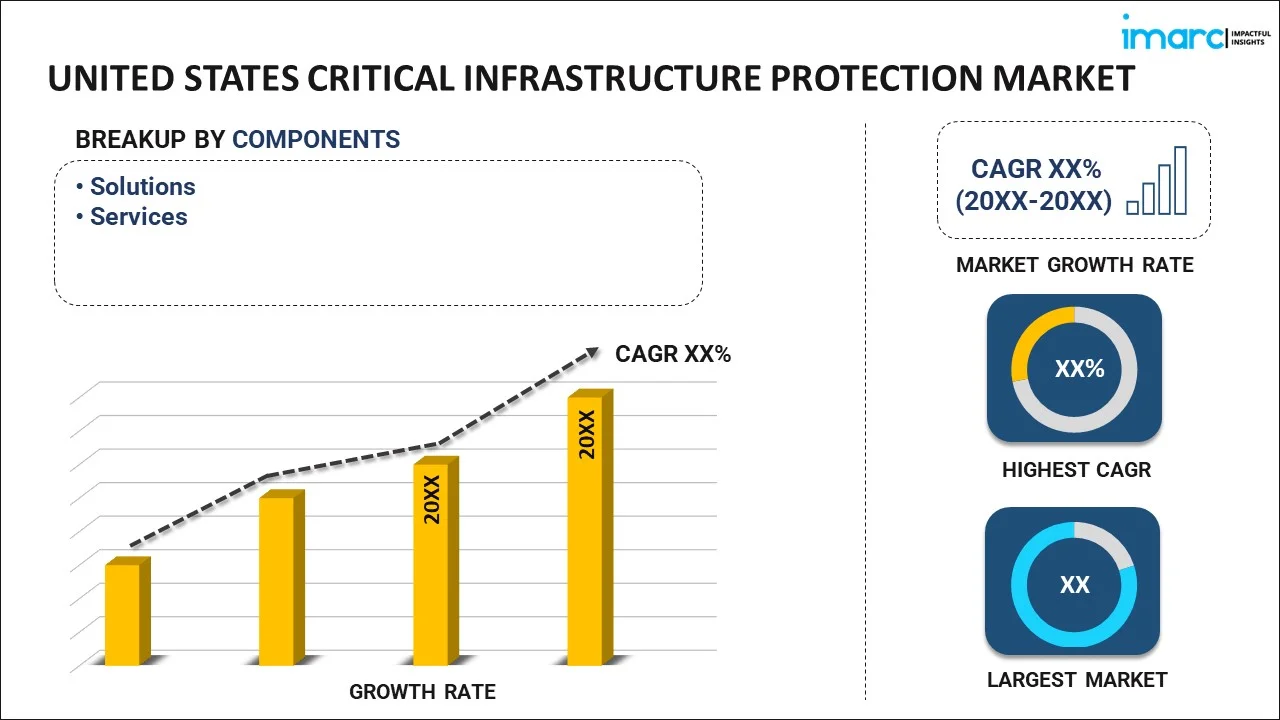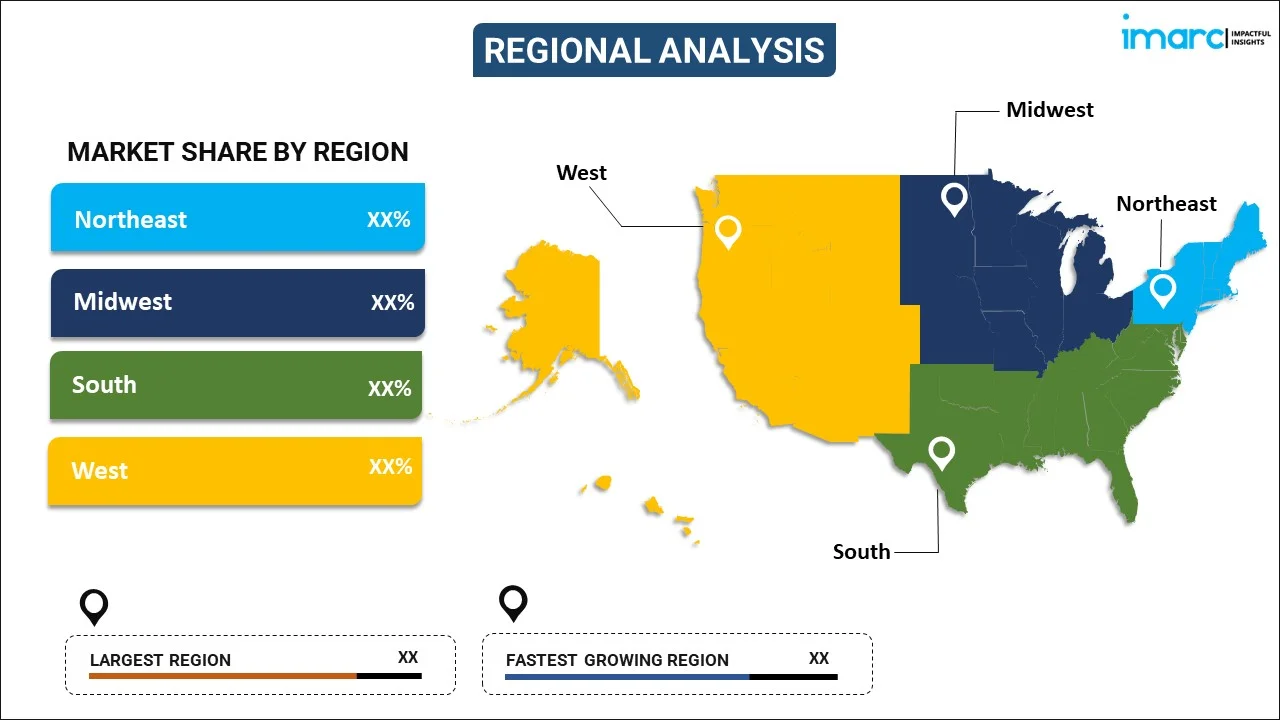
United States Critical Infrastructure Protection Market Report by Component (Solutions, Services), End User (Financial Institutions, Government, Defense, Transport and Logistics, Energy and Power, Commercial Sector, and Others), and Region 2024-2032
Market Overview:
United States critical infrastructure protection market size reached US$ 49.11 Billion in 2023. Looking forward, IMARC Group expects the market to reach US$ 79.52 Billion by 2032, exhibiting a growth rate (CAGR) of 5.10% during 2024-2032. The launch of stringent regulations by government bodies against cyber-attacks that pose a threat to infrastructural development is primarily driving the market growth across the country.
|
Report Attribute
|
Key Statistics
|
|---|---|
|
Base Year
|
2023 |
|
Forecast Years
|
2024-2032 |
|
Historical Years
|
2018-2023
|
| Market Size in 2023 | US$ 49.11 Billion |
| Market Forecast in 2032 | US$ 79.52 Billion |
| Market Growth Rate (2024-2032) | 5.10% |
Critical infrastructure protection (CIP) entails a security strategy employed to defend systems, assets, and networks against potential threats. This comprehensive approach encompasses a variety of security solutions, including firewalls, identity and access management, risk and compliance management, antivirus software, intrusion detection systems, and encryption systems. Its primary objective is to secure information associated with critical sectors like power grids, railways, nuclear plants, and hydro plants, shielding them from cyber threats that could jeopardize public safety, national security, or result in environmental disasters. Critical infrastructure protection solutions also incorporate wireless technology, industrial control systems (ICS), operational technology (OT), and supervisory control and data acquisition (SCADA) systems to identify and address additional security vulnerabilities.
United States Critical Infrastructure Protection Market Trends:
The United States critical infrastructure protection market plays a pivotal role in fortifying systems, assets, and networks against potential threats, safeguarding vital sectors crucial for the nation's functioning. Additionally, this dynamic market encompasses a range of security solutions, including firewalls, identity and access management, risk and compliance management, antivirus measures, intrusion detection systems, and encryption systems. Moreover, with the elevating focus on protecting information integral to power grids, railways, nuclear plants, and hydro plants, the United States critical infrastructure protection market addresses the ever-growing risk of cyberattacks that could pose threats to public safety, national security, and environmental stability. Besides this, embracing wireless technology, industrial control systems (ICS), operational technology (OT), and supervisory control and data acquisition (SCADA) systems, critical infrastructure protection solutions in the U.S. strive to identify and mitigate potential security vulnerabilities. In line with this, as the dependence on digital infrastructure intensifies across critical sectors and the imperative to bolster resilience against evolving cyber threats and ensuring the uninterrupted and secure functioning, the United States critical infrastructure protection market is poised for continued growth over the forecasted period.
United States Critical Infrastructure Protection Market Segmentation:
IMARC Group provides an analysis of the key trends in each segment of the market, along with forecasts at the country level for 2024-2032. Our report has categorized the market based on component and end user.
Component Insights:

- Solutions
- Physical Security Solutions
- Physical Identity and Access Control Systems
- Perimeter Intrusion Detection Systems
- Video Surveillance Systems
- Screening and Scanning
- Others
- Cyber Security Solutions
- Encryption
- Network Access Control and Firewall
- Threat Intelligence
- Others
- Physical Security Solutions
- Services
- Designing and Integration Services
- Consultation Services
- Risk Management Services
- Maintenance and Support Services
The report has provided a detailed breakup and analysis of the market based on the component. This includes solutions [physical security solutions (physical identity and access control systems, perimeter intrusion detection systems, video surveillance systems, screening and scanning, and others) and cyber security solutions (encryption, network access control and firewall, threat intelligence, and others)] and services (designing and integration services, consultation services, risk management services, and maintenance and support services).
End User Insights:
- Financial Institutions
- Government
- Defense
- Transport and Logistics
- Energy and Power
- Commercial Sector
- Others
A detailed breakup and analysis of the market based on the end user have also been provided in the report. This includes financial institutions, government, defense, transport and logistics, energy and power, commercial sector, and others.
Regional Insights:

- Northeast
- Midwest
- South
- West
The report has also provided a comprehensive analysis of all the major regional markets, which include Northeast, Midwest, South, and West.
Competitive Landscape:
The market research report has also provided a comprehensive analysis of the competitive landscape in the market. Competitive analysis such as market structure, key player positioning, top winning strategies, competitive dashboard, and company evaluation quadrant has been covered in the report. Also, detailed profiles of all major companies have been provided.
United States Critical Infrastructure Protection Market Report Coverage:
| Report Features | Details |
|---|---|
| Base Year of the Analysis | 2023 |
| Historical Period | 2018-2023 |
| Forecast Period | 2024-2032 |
| Units | US$ Billion |
| Scope of the Report | Exploration of Historical Trends and Market Outlook, Industry Catalysts and Challenges, Segment-Wise Historical and Future Market Assessment:
|
| Components Covered |
|
| End Users Covered | Financial Institutions, Government, Defense, Transport and Logistics, Energy and Power, Commercial Sector, Others |
| Regions Covered | Northeast, Midwest, South, West |
| Customization Scope | 10% Free Customization |
| Report Price and Purchase Option | Single User License: US$ 3699 Five User License: US$ 4699 Corporate License: US$ 5699 |
| Post-Sale Analyst Support | 10-12 Weeks |
| Delivery Format | PDF and Excel through Email (We can also provide the editable version of the report in PPT/Word format on special request) |
Key Questions Answered in This Report:
- How has the United States critical infrastructure protection market performed so far and how will it perform in the coming years?
- What has been the impact of COVID-19 on the United States critical infrastructure protection market?
- What is the breakup of the United States critical infrastructure protection market on the basis of component?
- What is the breakup of the United States critical infrastructure protection market on the basis of end user?
- What are the various stages in the value chain of the United States critical infrastructure protection market?
- What are the key driving factors and challenges in the United States critical infrastructure protection?
- What is the structure of the United States critical infrastructure protection market and who are the key players?
- What is the degree of competition in the United States critical infrastructure protection market?
Key Benefits for Stakeholders:
- IMARC’s industry report offers a comprehensive quantitative analysis of various market segments, historical and current market trends, market forecasts, and dynamics of the United States critical infrastructure protection market from 2018-2032.
- The research report provides the latest information on the market drivers, challenges, and opportunities in the United States critical infrastructure protection market.
- Porter's five forces analysis assist stakeholders in assessing the impact of new entrants, competitive rivalry, supplier power, buyer power, and the threat of substitution. It helps stakeholders to analyze the level of competition within the United States critical infrastructure protection industry and its attractiveness.
- Competitive landscape allows stakeholders to understand their competitive environment and provides an insight into the current positions of key players in the market.
Need more help?
- Speak to our experienced analysts for insights on the current market scenarios.
- Include additional segments and countries to customize the report as per your requirement.
- Gain an unparalleled competitive advantage in your domain by understanding how to utilize the report and positively impacting your operations and revenue.
- For further assistance, please connect with our analysts.
 Inquire Before Buying
Inquire Before Buying
 Speak to an Analyst
Speak to an Analyst
 Request Brochure
Request Brochure
 Request Customization
Request Customization




.webp)




.webp)












